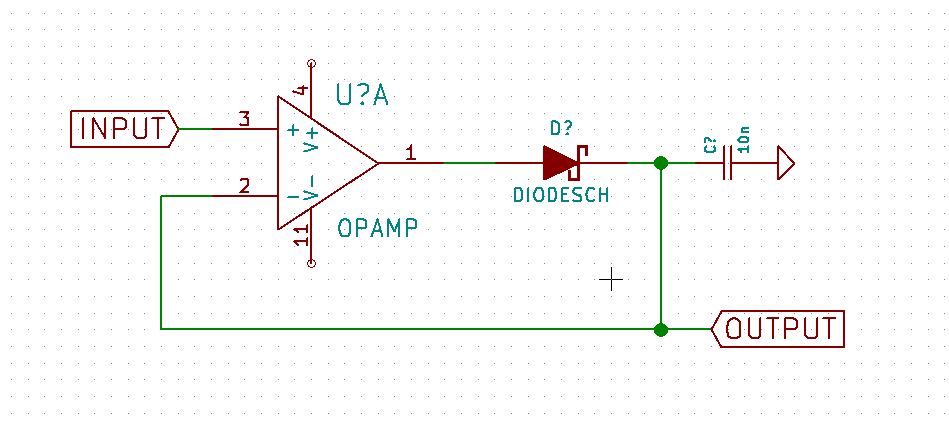So I finally figured out what was wrong with the PCBs... turns out the schottky diodes I was using don't work properly for this application. They were the one component which was different between my breadboard circuit and the PCB. On the breadboard I was using a through hole BAT48 from my junk bin, and it worked fine; after soldering the SMD diodes that I had used on the board onto some pins so that I could use it in the breadboard, I was able to reproduce the same errors that I saw on my PCB.
I have no idea why it is not working; I am not a diode expert, but I don't see anything in the datasheet which jumps out at me.
The bad diodes' datasheet is http://www.mouser.com/ds/2/302/PMEG3010ER-353425.pdf .
The good diodes' datasheet is http://www.st.com/web/en/resource/technical/document/datasheet/CD00000768.pdf . (In addition to BAT48, I tried some other diodes in my junk bin, including BAT46 and some random, thick 1.5A power diodes I bought years ago and don't remember what model they are... all of them work.)
If anyone has an insight on what is different between these two diodes that could cause the difference, please let me know. The circuit in question is a simple peak hold circuit using an op amp, diode, and capacitor:
 Input is connected (via some other components) to the piezo which gives an oscilating waveform; output should be the max voltage of the input wave.
Input is connected (via some other components) to the piezo which gives an oscilating waveform; output should be the max voltage of the input wave.
When using BAT48 as the diode, it works perfectly. When using PMEG3010ER it doesn't (the output pretty much just mirrors the input, so you see a quickly oscillating waveform).
Oh well... regardless of the root cause, I now know what I need to do to get it working. I guess another Digikey order is coming up soon... ;-)
Cheers
 The Big One
The Big One
Discussions
Become a Hackaday.io Member
Create an account to leave a comment. Already have an account? Log In.
Very big thanks to everyone! I ended up using a generic non-schottky diode and the thing works beautifully. Furthermore, for the low cost of about $30 in components to re-do the board, I learned way more about diodes than I had known previously.
I really appreciate all the comments and hints as I stumble through this (and other) projects!
Cheers
Are you sure? yes | no
Don't use a rectifier to replace a signal diode.
One is a rectifier diode with huge reverse leakages:
reverse current VR = 30 V - 0.6 1.5 mA
The other other is a signal diode:
V R = 20V 10uA
The rectifier would leak the charge from the cap defeating the whole purpose of the circuit.
Are you sure? yes | no
Thanks! Yeah, that is a huge difference... I had bought them originally for use in a power supply, for which they worked great. I have learned my lesson!
Are you sure? yes | no
I don't see a big difference between the two diodes... Usually another opamp is used as a buffer at the output of a peak detector. That's to avoid a discharge of the capacitor, which could make the output signal look like the input. I don't know what connected to the output of your peak detector, but if the impedance is two small, that could explain why the signal looks like the input. That doesn't really explain why it's happening with only one of the two diodes though. Anyway, at least you have a solution to the problem, that's a good thing! Hope to see it working soon. Cheers.
Are you sure? yes | no
Yeah, the output from this stage is buffered and amplified by an op amp (amplification value is determined by an I2C digital pot); I just didn't include it in this simplified diagram since that part is working.
In my upcoming Digikey order I am actually going to order a couple different diodes in the proper footprint (including BAT48 schottkeys and some generic, general purpose (non schottkey) diodes). Hopefully this will ensure that at least one type of diode works properly...
Are you sure? yes | no
[this comment has been deleted]
Hmm... yes, the forward voltage does vary between them. The 'bad' diode has a lower forward voltage, though; nominally 230mV at 0.1A, whereas BAT48 has around 500mV at the same current. I would have assumed that lower is better, though, so unless I am missing something, the BAT48 should have been better here.
The capacitance, however, could definitely do some bad things... I hadn't realized how much higher it was. Unless I find something else that I missed, I could definitely chalk the problems up to that.
Thanks for the time!
Are you sure? yes | no
The circuit has negative feedback for the forward direction that would compensate for diode drops.
FYI: Schottky diodes has higher reverse leakages than silicon diodes.
Are you sure? yes | no